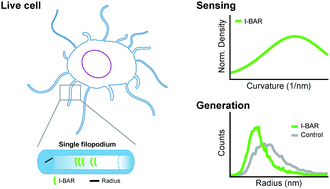Quantitative investigation of negative membrane curvature sensing and generation by I-BARs in filopodia of living cells†
Abstract
Membrane curvature has recently been recognized as an active regulator of cellular function, with several protein families identified as sensors and generators of membrane curvature. Amongst them, the inverse Bin/Amphiphysin/Rvs (I-BAR) domain family has been implicated in the sensing and generation of membrane structures with negative membrane curvature e.g. filopodia or dendritic spines. However, to date, quantitative biophysical investigations of I-BAR domains have mostly taken place in reconstitution. Here, we use fluorescence microscopy to quantitatively investigate membrane curvature sensing and generation by I-BARs in filopodia of living cells. As a model system, we selected two prototypic members of the I-BAR family, the insulin receptor substrate p53 and missing-in-metastasis. Our data demonstrated how I-BARs sense negative membrane curvature in the complex environment of live cells by revealing a dependence on membrane curvature for both their binding affinity to membranes and their saturation density. The non-monotonic dependence of protein sorting with negative membrane curvature allowed us to apply previously developed thermodynamic models to provide estimates of the effective intrinsic curvature and bending rigidity of the two I-BARs bound at the plasma membrane. Our results agree with studies performed on the insulin receptor substrate p53 in reconstitution. To quantitate membrane curvature generation by I-BARs we measured how their overexpression reduces the peak and the width of the size distribution of filopodia, resulting in filopodia populations with smaller and more uniform diameters. Our findings provide a quantitative biophysical insight in the ability of I-BARs to sense and generate negative membrane curvature in the crowded environment of living cells.

- This article is part of the themed collection: Remodelling of Biomembranes


 Please wait while we load your content...
Please wait while we load your content...